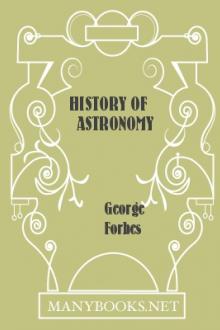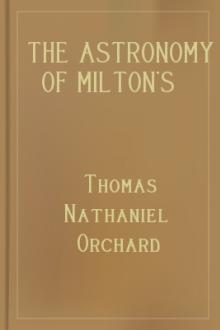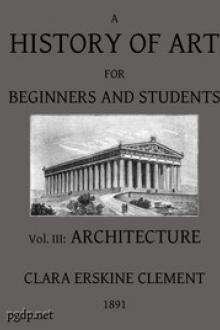History of Astronomy by George Forbes (classic children's novels TXT) 📕

- Author: George Forbes
- Performer: -
Book online «History of Astronomy by George Forbes (classic children's novels TXT) 📕». Author George Forbes
On examining artificial lights it was found that incandescent solids and liquids (including the carbon glowing in a white gas flame) give continuous spectra; gases, except under enormous pressure, give bright lines. If sodium or common salt be thrown on the colourless flame of a spirit lamp, it gives it a yellow colour, and its spectrum is a bright yellow line agreeing in position with line D of the solar spectrum.
In 1832 Sir David Brewster found some of the solar black lines increased in strength towards sunset, and attributed them to absorption in the earth’s atmosphere. He suggested that the others were due to absorption in the sun’s atmosphere. Thereupon Professor J. D. Forbes pointed out that during a nearly total eclipse the lines ought to be strengthened in the same way; as that part of the sun’s light, coming from its edge, passes through a great distance in the sun’s atmosphere. He tried this with the annular eclipse of 1836, with a negative result which has never been accounted for, and which seemed to condemn Brewster’s view.
In 1859 Kirchoff, on repeating Frauenhofer’s experiment, found that, if a spirit lamp with salt in the flame were placed in the path of the light, the black D line is intensified. He also found that, if he used a limelight instead of the sunlight and passed it through the flame with salt, the spectrum showed the D line black; or the vapour of sodium absorbs the same light that it radiates. This proved to him the existence of sodium in the sun’s atmosphere.[4] Iron, calcium, and other elements were soon detected in the same way.
Extensive laboratory researches (still incomplete) have been carried out to catalogue (according to their wave-length on the undulatory theory of light) all the lines of each chemical element, under all conditions of temperature and pressure. At the same time, all the lines have been catalogued in the light of the sun and the brighter of the stars.
Another method of obtaining spectra had long been known, by transmission through, or reflection from, a grating of equidistant lines ruled upon glass or metal. H. A. Rowland developed the art of constructing these gratings, which requires great technical skill, and for this astronomers owe him a debt of gratitude.
In 1842 Doppler[5] proved that the colour of a luminous body, like the pitch or note of a sounding body, must be changed by velocity of approach or recession. Everyone has noticed on a railway that, on meeting a locomotive whistling, the note is lowered after the engine has passed. The pitch of a sound or the colour of a light depends on the number of waves striking the ear or eye in a second. This number is increased by approach and lowered by recession.
Thus, by comparing the spectrum of a star alongside a spectrum of hydrogen, we may see all the lines, and be sure that there is hydrogen in the star; yet the lines in the star-spectrum may be all slightly displaced to one side of the lines of the comparison spectrum. If towards the violet end, it means mutual approach of the star and earth; if to the red end, it means recession. The displacement of lines does not tell us whether the motion is in the star, the earth, or both. The displacement of the lines being measured, we can calculate the rate of approach or recession in miles per second.
In 1868 Huggins[6] succeeded in thus measuring the velocities of stars in the direction of the line of sight.
In 1873 Vogel[7] compared the spectra of the sun’s East (approaching) limb and West (receding) limb, and the displacement of lines endorsed the theory. This last observation was suggested by Zöllner.
FOOTNOTES:
[1] In the Encyclopaedia Britannica, article “Telescope,” and in Grant’s Physical Astronomy, good reasons are given for awarding the honour to Lipperhey.
[2] Will the indulgent reader excuse an anecdote which may encourage some workers who may have found their mathematics defective through want of use? James Gregory’s nephew David had a heap of MS. notes by Newton. These descended to a Miss Gregory, of Edinburgh, who handed them to the present writer, when an undergraduate at Cambridge, to examine. After perusal, he lent them to his kindest of friends, J. C. Adams (the discoverer of Neptune), for his opinion. Adams’s final verdict was: “I fear they are of no value. It is pretty evident that, when he wrote these notes, Newton’s mathematics were a little rusty.”
[3] R. S. Phil. Trans.
[4] The experiment had been made before by one who did not understand its meaning;. But Sir George G. Stokes had already given verbally the true explanation of Frauenhofer lines.
[5] Abh. d. Kön. Böhm. d. Wiss., Bd. ii., 1841-42, p. 467. See also Fizeau in the Ann. de Chem. et de Phys., 1870, p. 211.
[6] R. S. Phil. Trans., 1868.
[7] Ast. Nach., No. 1, 864.
BOOK IV. THE PHYSICAL PERIOD
We have seen how the theory of the solar system was slowly developed by the constant efforts of the human mind to find out what are the rules of cause and effect by which our conception of the present universe and its development seems to be bound. In the primitive ages a mere record of events in the heavens and on the earth gave the only hope of detecting those uniform sequences from which to derive rules or laws of cause and effect upon which to rely. Then came the geometrical age, in which rules were sought by which to predict the movements of heavenly bodies. Later, when the relation of the sun to the courses of the planets was established, the sun came to be looked upon as a cause; and finally, early in the seventeenth century, for the first time in history, it began to be recognised that the laws of dynamics, exactly as they had been established for our own terrestrial world, hold good, with the same rigid invariability, at least as far as the limits of the solar system.
Throughout this evolution of thought and conjecture there were two types of astronomers—those who supplied the facts, and those who supplied the interpretation through the logic of mathematics. So Ptolemy was dependent upon Hipparchus, Kepler on Tycho Brahe, and Newton in much of his work upon Flamsteed.
When Galileo directed his telescope to the heavens, when Secchi and Huggins studied the chemistry of the stars by means of the spectroscope, and when Warren De la Rue set up a photoheliograph at Kew, we see that a progress in the same direction as before, in the evolution of our conception of the universe, was being made. Without definite expression at any particular date, it came to be an accepted fact that not only do earthly dynamics apply to the heavenly bodies, but that the laws we find established here, in geology, in chemistry, and in the laws of heat, may be extended with confidence to the heavenly bodies. Hence arose the branch of astronomy called astronomical physics, a science which claims a large portion of the work of the telescope, spectroscope, and photography. In this new development it is more than ever essential to follow the dictum of Tycho Brahe—not to make theories until all the necessary facts are obtained. The great astronomers of to-day still hold to Sir Isaac Newton’s declaration, “Hypotheses non fingo.” Each one may have his suspicions of a theory to guide him in a course of observation, and may call it a working hypothesis. But the cautious astronomer does not proclaim these to the world; and the historian is certainly not justified in including in his record those vague speculations founded on incomplete data which may be demolished to-morrow, and which, however attractive they may be, often do more harm than good to the progress of true science. Meanwhile the accumulation of facts has been prodigious, and the revelations of the telescope and spectroscope entrancing.
12. THE SUN.
One of Galileo’s most striking discoveries, when he pointed his telescope to the heavenly bodies, was that of the irregularly shaped spots on the sun, with the dark central umbra and the less dark, but more extensive, penumbra surrounding it, sometimes with several umbrae in one penumbra. He has left us many drawings of these spots, and he fixed their period of rotation as a lunar month.
[Illustration: SOLAR SURFACE, As Photographed at the Royal Observatory, Greenwich, showing sun-spots with umbrae, penumbrae, and faculae.]
It is not certain whether Galileo, Fabricius, or Schemer was the first to see the spots. They all did good work. The spots were found to be ever varying in size and shape. Sometimes, when a spot disappears at the western limb of the sun, it is never seen again. In other cases, after a fortnight, it reappears at the eastern limb. The faculae, or bright areas, which are seen all over the sun’s surface, but specially in the neighbourhood of spots, and most distinctly near the sun’s edge, were discovered by Galileo. A high telescopic power resolves their structure into an appearance like willow-leaves, or rice-grains, fairly uniform in size, and more marked than on other parts of the sun’s surface.
Speculations as to the cause of sun-spots have never ceased from Galileo’s time to ours. He supposed them to be clouds. Scheiner[1] said they were the indications of tumultuous movements occasionally agitating the ocean of liquid fire of which he supposed the sun to be composed.
A. Wilson, of Glasgow, in 1769,[2] noticed a movement of the umbra relative to the penumbra in the transit of the spot over the sun’s surface; exactly as if the spot were a hollow, with a black base and grey shelving sides. This was generally accepted, but later investigations have contradicted its universality. Regarding the cause of these hollows, Wilson said:—
Whether their first production and subsequent numberless changes depend upon the eructation of elastic vapours from below, or upon eddies or whirlpools commencing at the surface, or upon the dissolving of the luminous matter in the solar atmosphere, as clouds are melted and again given out by our air; or, if the reader pleases, upon the annihilation and reproduction of parts of this resplendent covering, is left for theory to guess at.[3]
Ever since that date theory has been guessing at it. The solar astronomer is still applying all the instruments of modern research to find out which of these suppositions, or what modification of any of them, is nearest the truth. The obstacle—one that is perhaps fatal to a real theory—lies in the impossibility of reproducing comparative experiments in our laboratories or in our atmosphere.
Sir William Herschel propounded an explanation of Wilson’s observation which received much notice, but which, out of respect for his memory,





Comments (0)